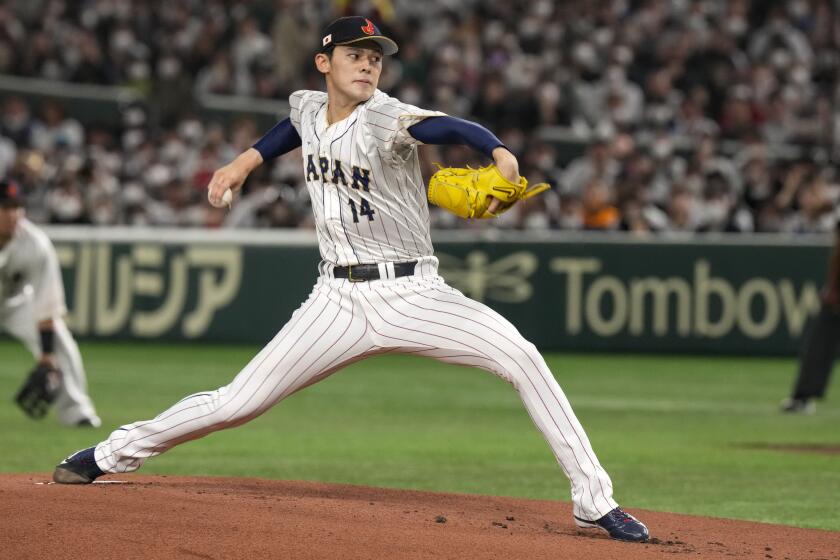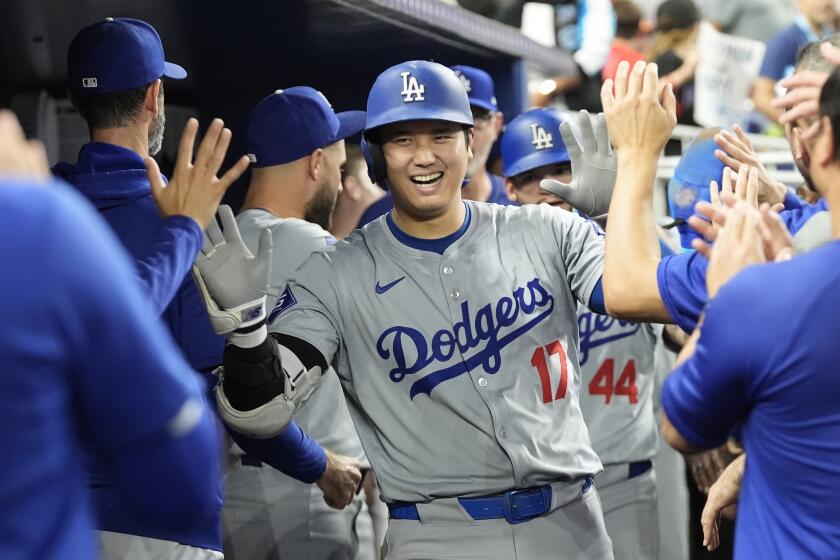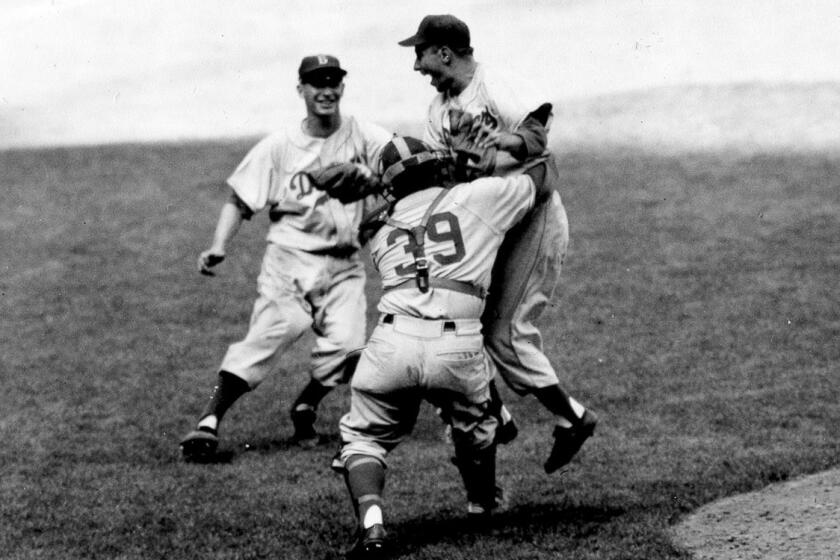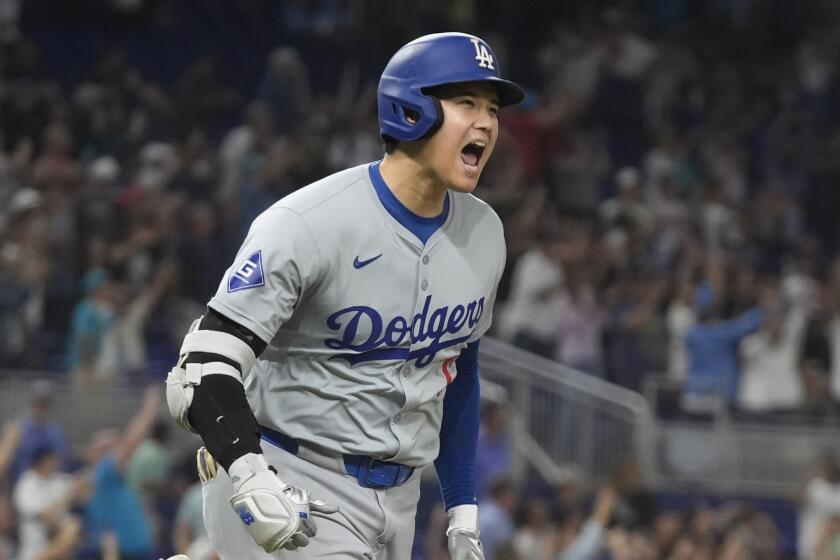1988 Dodgers Revisited
TOM LASORDA, manager.
What he’s doing now: interim general manager, Dodgers.
Memory: “You know who I had out there in the last game of the World Series? Hershiser, Dempsey, Stubbs, Sax, Griffin, Hamilton, Hatcher in left, Shelby and Danny Heep in right. . . . [Before Game 4], I wasn’t going to have a meeting that night. But then [Bill] Russell came over and told me that Mike Marshall couldn’t play. And that really burned me up. So I had a meeting and did a little screaming and hollering. And then I turned on the television and [Bob] Costas comes out and says this may be the worst team ever put on the field in World Series history. That’s when I said, ‘Can you believe this guy? Can you believe it?’ ”
*
MIKE SCIOSCIA, catcher.
Notable 1988 numbers: had three home runs in regular season, all game-winners; one home run, which tied Game 4, in league championship series.
Left the Dodgers: after 1992 season.
What he’s doing now: bench coach, Dodgers.
Memory: “What I remember is less the fabulous year Hershiser had or Gibson being MVP. It was the little things, like Mickey Hatcher moving the runner over, Franklin Stubbs getting key hits for us, Rick Dempsey coming off the bench and playing a good game for us, Alfredo Griffin. . . . That whole team was a bunch of gamers--guys who wanted to play, who wanted to win. We weren’t the most individually talented club. But we were by far the best team.”
*
JOE AMALFITANO, coach.
What he’s doing now: Dodger coach.
Memory: “I’ll always remember the expression on Doc Gooden’s face in the ninth inning [in Game 4 of the NL playoffs, ahead by two runs in the ninth] after he walked John Shelby. He had realized what he had done. And I think on the next pitch to [Mike] Scioscia, he was still thinking about that. He was upset with himself, and Scioscia hit the home run. When those two things happened, two things that didn’t happen to a very, very good pitcher that often, I thought maybe it was our turn. I really did.”
*
(*) DAVE ANDERSON, utility infielder.
Notable 1988 number: started 60 of 61 games from May 21 through July 24 after Alfredo Griffin broke his hand; Dodgers went 35-26 in that span.
Left the Dodgers: after 1989 season, returned in 1992 for 52 games.
What he’s doing now: manager, double-A Jacksonville in Detroit Tiger organization.
Memory: “I think in the eight years I played in Los Angeles, that was the best year Tommy [Lasorda] had managing. He had a lot of veteran players, and I think Tommy likes having veteran ballplayers, because he knows they know how to play and he can use them in different situations.”
*
TIM BELCHER, starting pitcher.
Notable 1988 number: Won nine of his last 11 regular-season decisions.
Left the Dodgers: after 1991 season.
What he’s doing now: starting pitcher, Kansas City Royals.
Memory: “I think [the ’88 season] made my career. I don’t think there’s any question about it. At the time I was traded to the Dodgers for Rick Honeycutt . . . I’d spent four years in the minor leagues, and I was becoming, in a lot of people’s eyes, more of a suspect than a prospect. And to be a key member of a world’s championship team in ‘88, rookie pitcher of the year and everything. . . . Had that move never happened or had we never won or had I never been an integral part of the winning, I think my career would’ve been quite a bit different.”
*
(-) TIM CREWS, relief pitcher.
Notable 1988 number: 4-0 in 42 appearances; left off postseason roster after acquisition of Ricky Horton.
Left the Dodgers: after 1992 season.
Died in boating accident, March 23, 1993.
*
FRED CLAIRE, executive vice president.
Left the Dodgers: fired this season.
Memory: “I remember what happened to Gilberto Reyes. Scioscia injured his back [in Game 4 of the World Series] and we had gotten permission from [then-Commissioner] Peter Ueberroth to bring Reyes to Oakland. I had him fly in from the Dominican. He flies out--he got there the night of what proved to be the final game. He walks into the clubhouse about the time they started popping champagne bottles. The guy has flown in all the way from the Dominican Republic to get soaked in champagne.”
*
ALFREDO GRIFFIN, shortstop.
Notable 1988 number: hit career-low .199.
Left the Dodgers: after 1991 season.
What he’s doing now: manager, Dominican Winter League.
*
DANNY HEEP, reserve first baseman and outfielder.
Notable 1988 number: hit .305 in 35 starts.
Left the Dodgers: after 1988 season.
What he’s doing now: baseball coach, University of the Incarnate Word in San Antonio.
*
MIKE DAVIS, reserve outfielder.
Notable 1988 number: Hit only two home runs in regular season, but hit two-run shot in World Series, clinching Game 5.
Left the Dodgers: after 1989 season.
What he’s doing now: part-owner, International Scanning Systems, a company that converts information on paper to CD-ROM. Living in Santa Clarita.
Memory: “When I came up in the ninth [in Game 1 of the World Series against Dennis Eckersley], I was looking forward to doing some big things. And the truth is, if I would’ve written the script, it would’ve been Kirk Gibson who would’ve gotten the walk, and I would’ve hit the home run. I fouled off his first pitch, but then I think he threw four pitches in a row that were seven inches outside. Not even close. I played with Dennis and had gotten some big hits for the A’s. But I don’t think he read the box scores. . . . If he had, he would’ve thrown every pitch down the middle of the plate.”
*
JOSE GONZALEZ, reserve outfielder.
Notable 1988 number: called up and sent back down to Albuquerque three times before sticking with club Aug. 29.
Left the Dodgers: during the 1991 season.
What he’s doing now: believed to be playing in Mexican League.
*
RICK DEMPSEY, reserve catcher.
Notable 1988 number: batted .400 with two runs and two RBIs in league championship series.
Left the Dodgers: after the 1990 season.
What he’s doing now: manager, triple-A Norfolk Tides, New York Met organization.
Memory: “I remember one day in Cincinnati, Tim [Belcher] had started, had gone five innings or something like that and kind of ran out of gas. Fred [Claire] came in and said right in front of Timmy, ‘Hey, what do you think of this guy?’ I said, ‘You know, he’s a pretty good five-inning pitcher.’ And boy did Tim ever get mad! . . . I said, ‘Tim, the way you pitch, you don’t have a good off-speed pitch, and after five innings, they figure you out.’ The next thing you know, he has an off-speed pitch overnight--a split-finger fastball--and the guy’s 12-6 and he just had a fabulous year and he learned something about pitching. When he won his 100th game, he sent me the ball.”
*
BRIAN HOLTON, relief pitcher.
Notable 1988 number: had team-low 1.70 ERA in 45 appearances.
Left the Dodgers: after 1988 season.
What he’s doing now: information not available.
*
KIRK GIBSON, left fielder.
Notable 1988 numbers: scored 106 runs, had .377 on-base percentage.
Left the Dodgers: after 1990 season.
What he’s doing now: commentator, Fox Sports Detroit’s broadcasts of Detroit Tiger games.
Memory: “I tell people that I was an average ballplayer who did some exceptional things at the right time. You know what? That’s how I saw myself. I never cared about making the Hall of Fame. I never cared about hitting .300 or .400. I never cared about making the All-Star team. And you know what? I didn’t do any of that and I won’t do any of that. But I did care about becoming a world champion, and sacrificing for the team, for the fans, for the organization, for the city.”
*
TIM LEARY, starting pitcher.
Notable 1988 number: won 17 games; never won more than 11 before or after in his 15-year career.
Left the Dodgers: during 1989 season.
What he’s doing now: pitching coach, UCLA baseball team.
*
JEFF HAMILTON, third baseman.
Notable number: sixth homer of season beat Red closer John Franco on Sept. 11.
Left the Dodgers: after 1991 season.
What he’s doing now: mortgage banker in Fenton, Mich.
Memory: “Every time somebody got close, we pulled away. After the All-Star break, things were kind of tight, and how many in a row did we win in Chicago, five in a row? We kind of knew we were going to win the game. It’s a lot different knowing you’re going to win than worrying if you’re going to win. The whole thing starts in the clubhouse, and I think you could’ve sat everybody on that team around a table, had a meal and not bickered. And that never happens.”
*
(-) RAMON MARTINEZ, pitcher.
Notable 1988 numbers: started six games after late call-up, pitched 7 2/3 innings in Aug. 13 no-decision against Giants in major league debut.
What he’s doing now: disabled list, Dodgers.
Memory: “I got called up in the last month of the season, and when you’re winning, everything’s fun. Every game we played was exciting. I didn’t get to play in the World Series. . . . I want to have that chance some day, to be in a World Series. I hope soon, before I retire.”
*
MICKEY HATCHER, utility player.
Notable 1988 number: hit one home run in regular season; hit two in World Series.
Left the Dodgers: after 1990 season.
What he’s doing now: Dodger batting coach.
Memory: “It was a big year for me, because I’d been left out of two World Series--the Dodgers got rid of me [in 1981], then they won the World Series. The Minnesota Twins got rid of me in ‘87, they won the World Series. In ‘88, I told these guys, ‘We better get to the World Series because I’m tired of this stuff.’ I thought they might trade me the last month, because everybody who got rid of me, they won the World Series. I don’t think I slept for the playoffs and World Series. I wanted to live at the ballpark.”
*
STEVE SAX, second baseman.
Notable 1988 numbers: played in most games, 160, and had most hits on team, 175.
Left the Dodgers: after 1988 season.
What he’s doing now: commentator, Fox Sports studio shows.
Memory: “We were picked fourth that year by the brilliant press. As it turned out, we just hung in there until the later part of the year, when we started to pull away. Our pitching staff was just absolutely dominant the whole year. That was really the key to our team.”
*
OREL HERSHISER, starting pitcher.
Notable 1988 number: 59 shutout innings. Started streak with four scoreless innings to finish Aug. 30 victory over Expos, threw five straight shutouts to get to 49, needed a 10-inning scoreless tie game to reach record-breaking 59 against San Diego on Sept. 28, then left game.
Left the Dodgers: after 1994 season.
What he’s doing now: starting pitcher, San Francisco Giants.
Memory: “I was jumping around like everybody else [after Gibson’s World Series Game 1 homer], and I forgot my scouting tape because I was so excited. I ended up having to make a little cheat sheet to have in my back pocket to tell me what to do. And Durwood Merrill was the home plate umpire [in Game 2], and I said, ‘If you see me going to my pocket during the game, this is what it is. It’s not sandpaper or anything. I needed to scout, I forgot.’ And Doug Harvey was still in the meeting, and Durwood said to him, ‘You told me about this guy. . . . ‘ “
*
ALEJANDRO PENA, relief pitcher.
Notable 1988 number: gave up only two earned runs in 9 1/3 innings of postseason play.
Left the Dodgers: after 1989 season.
What he’s doing now: living in Atlanta area.
*
FRANKLIN STUBBS, first baseman.
Notable 1988 number: hit .294 in World Series, with three runs and two RBIs.
Left the Dodgers: after 1989 season.
What he’s doing now: manager of Class-A Danville in Atlanta Brave organization.
Memory: “Lasorda liked to have those meetings. But we never had a real losing streak that year, so he could really never have a meeting. It was funny, he had a meeting one time just for the heck of it. I said, ‘Wow, this is funny. He’s having a meeting just for the heck of one.’ But there really wasn’t anything he could say because everything was working. And when everything’s working like that type of year, you just sit back and watch it . . . you just sit back and enjoy.”
Also: “Tell Mr. O’Malley and Mrs. Campanella I said hello, please.”
*
TRACY WOODSON, utility player.
Notable 1988 number: started 29 games at third from July 27 to Sept. 1 after Hamilton’s injury.
Left the Dodgers: after 1989 season.
What he’s doing: manager, Class-A Erie in Pittsburgh Pirate organization.
*
JAY HOWELL, relief pitcher.
Notable 1988 number: 13 for 16 in regular-season save opportunities after All-Star break.
Left the Dodgers: after 1992 season.
What he’s doing now: owner of an Atlanta speciality-advertisement and sportswear company.
Memory: “I told [National League President Bart Giamatti] that what bothers me about [being suspended for two games during the league championship series for having pine tar on his glove] is at least if I appealed, I would be able to explain my motivation. I said, ‘Everyone will equate me with cheating. It’d be just like sandpaper. They’re not going to know the difference.’ He said, ‘They’re not going to pay any attention. You’ll be in the headlines for a couple more weeks, and somebody else is going to take over in a big way, let me tell you.’ And that was Pete Rose. I didn’t know it, but Pete was being investigated [for gambling on baseball]. Bart had his hands full. He said, ‘You’re not going to make headlines for long, I can assure you that.’ And wow, he was right.”
*
(+) MIKE SHARPERSON, utility infielder.
Notable 1988 numbers: appeared in 46 games, batted .271.
Left the Dodgers: after 1993 season.
Died in automobile accident May 26, 1996.
*
JOHN TUDOR, starting pitcher.
Notable 1988 number: was 4-3 with two no-decisions and a 2.41 ERA in nine starts with Dodgers.
Left the Dodgers: after 1989 season.
What he’s doing: living in Boston area, touring with celebrity softball team.
Memory: “It was a situation I got dropped into [after coming in a midseason trade]. And it was obviously a special moment for me. To actually be part of a winning team was fun. And as little I felt part of it, it was still fun. What I remember is just the team and the guys--Jay Howell and Gibby and Marshall and Hershiser and Shelby, all those guys. And Tim Crews and Sharperson, a couple guys who aren’t with us any more, unfortunately.”
*
MIKE MARSHALL, outfielder and first baseman.
Notable 1988 numbers: team-high 82 RBIs, played in career-high 144 games.
Left the Dodgers: after 1989 season.
What he’s doing now: director of the youth center at the West Austin Youth Assn., a privately run sports program in Austin, Texas.
Memory: “I think we probably should’ve won in ’85 [when the Dodgers lost in the league championship series to the St. Louis Cardinals], but we didn’t have a guy like Kirk Gibson. In ’88 it was Gibby. Gibby was the guy who taught us all how to win. That’s probably what we were missing in ’85.”
*
JESSE OROSCO, relief pitcher.
Notable 1988 number: appeared in 55 games, second-most on team.
Left the Dodgers: after 1988 season.
What he’s doing now: relief pitcher, Baltimore Orioles. This season became only sixth pitcher in history to appear in 1,000 games or more.
Memory: “I [put eye-black on Gibson’s cap] for fun. It faded kind of quick. Tommy Lasorda didn’t care for that. And Tommy didn’t say much to me ever again after that. The guys loved it. Kirk loved it. Kirk was mad at the time. It was the first game of spring training, he was pretty tense about the situation. The next day I told him, and he just said, ‘No big deal.’ Tommy was still fuming the next day, and pointing me out in the meeting. I probably wasn’t meant to be a Dodger long.”
*
RON PERRANOSKI, pitching coach.
Left the Dodgers: after 1993 season.
What he’s doing now: pitching coach, San Francisco Giants.
Memory: “[Hershiser’s scoreless innings streak] got down to the last couple of games, so it really was intensifying. I remember warming him up in the bullpen in San Diego in that last game. And Orel looked at me, ‘Gosh, Perry, I’m really nervous.’ I looked at him and said, ‘I’m real nervous, too.’ And he had to go 10 innings [to break Don Drysdale’s record of 58 2/3 innings], and that’s the way it went.”
*
RICKY HORTON, relief pitcher.
Notable 1988 number: did not give up a run in four appearances in league championship series.
Left the Dodgers: during 1989 season.
What he’s doing now: director of the Greater St. Louis ministry of the Fellowship of Christian Athletes.
Memory: “I have a moment in time from that year in ’88 that’s probably the moment from my life that sticks out the most. I was laying on the field in Oakland after we’d won the World Series and did the typical champagne craziness in the locker room. I went out and found my family and laid on the field and was holding my daughter and was just throwing her up and down. She was, I guess, about a year and a half. I can just recall that moment in time that almost just stood still for me.”
*
JOHN SHELBY, center fielder.
Notable 1988 number: had major league-best 24-game hitting streak, May 14-June 9.
Left the Dodgers: during 1990 season.
What he’s doing now: coach, Dodgers.
Memory: “When [Gibson] was up there and swinging [in Game 1 of the World Series], it didn’t look good. The only thing you could hope for is he hits the ball out of the park. You felt like if he hits the ball on the ground, he’d get thrown out. If he hit it in the gap somewhere, he probably wasn’t going to get an extra-base hit. Only thing I remember thinking, ‘Man, hope he hits it out.’ ”
LEGEND
(-) Was not on postseason roster.
(*) Was on World Series roster, but not on league championship series roster.
(+) Was on championship series roster, but not on World Series roster.
More to Read
Are you a true-blue fan?
Get our Dodgers Dugout newsletter for insights, news and much more.
You may occasionally receive promotional content from the Los Angeles Times.










